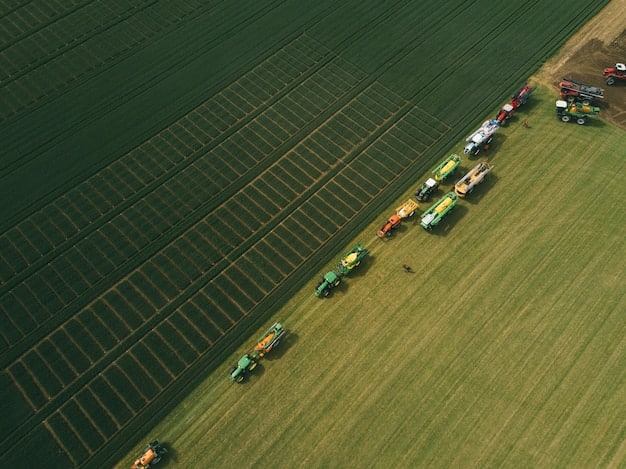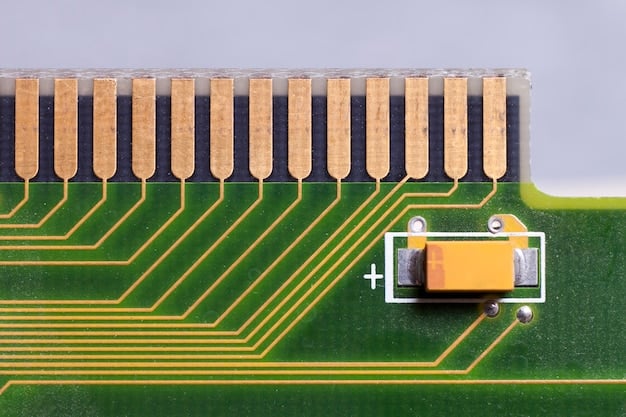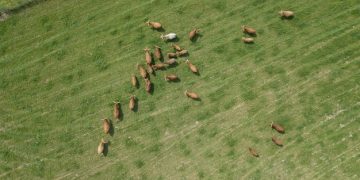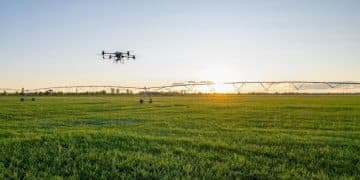Integrate AI into Your Farm Management System

Integrating AI into farm management systems enhances decision-making by providing data-driven insights, optimizing resource allocation, and improving overall farm productivity.
Discover how to integrate AI into your farm management system for improved decision-making, leading to increased efficiency, reduced costs, and more sustainable agricultural practices.
Artificial intelligence (AI) is rapidly transforming various sectors, and agriculture is no exception. Integrating AI into your farm management system can revolutionize your decision-making process, leading to increased efficiency, reduced costs, and more sustainable practices. This article explores the practical steps and benefits of adopting AI in farm management.
Understanding AI in Farm Management
Introducing AI into farm management involves leveraging advanced technologies to analyze data, automate tasks, and provide insights that improve overall farm operations. This section will explore the basics of AI and how it applies to agriculture.
AI is not just about robots and complex algorithms; it’s about using data to make smarter decisions. In agriculture, this means analyzing information from various sources to optimize planting, irrigation, harvesting, and more.
Here’s a breakdown of the core concepts:
- Machine Learning (ML): Algorithms that learn from data without explicit programming, enabling systems to predict outcomes and improve over time.
- Data Analytics: The process of examining raw data to draw conclusions about information, which can then be used to make informed decisions.
- Computer Vision: A field of AI that enables computers to “see” and interpret images, useful for monitoring crop health and identifying pests.
- Natural Language Processing (NLP): Allows computers to understand and process human language, enabling voice-controlled systems and chatbots for farm management.
Using AI, farmers can optimize resource allocation, predict crop yields, and detect diseases early, leading to more efficient and sustainable farming practices.

In conclusion, understanding the basics of AI and its applications is the first step towards integrating it into your farm management system. By leveraging these technologies, you can gain valuable insights and make data-driven decisions that improve your farm’s performance.
Assessing Your Farm’s Readiness for AI
Before diving into AI integration, it’s essential to assess your farm’s readiness. This involves evaluating your current infrastructure, data collection methods, and technological capabilities.
First, consider your existing technology infrastructure. Do you have reliable internet connectivity? Are your equipment and machinery compatible with AI-driven systems?
Key considerations include:
- Data Availability: AI thrives on data. Evaluate whether you have access to sufficient historical and real-time data on weather, soil conditions, crop yields, and other relevant factors.
- Equipment Compatibility: Ensure your machinery and equipment can integrate with AI systems. This may require upgrades or retrofits to enable data collection and automated control.
- Internet Connectivity: A stable and reliable internet connection is crucial for transmitting data and accessing AI services. Consider investing in improved connectivity if needed.
Identifying gaps in your current infrastructure will help you prioritize investments and develop a realistic implementation plan.
Assessing your farm’s readiness ensures a smoother integration process and maximizes the benefits of AI technologies.
Identifying Key Areas for AI Implementation
Identifying key areas where AI can provide the most significant impact is crucial for successful integration. Consider aspects like irrigation, pest control, and yield prediction. This section provides tailored guidance on identifying these opportunities within your farm.
Begin by pinpointing the most pressing challenges and inefficiencies on your farm. Where are you experiencing the highest costs, lowest yields, or greatest resource waste?
Here are some areas where AI can make a substantial difference:
- Precision Irrigation: AI can analyze weather data, soil moisture levels, and plant needs to optimize irrigation schedules, reducing water waste and improving crop health.
- Pest and Disease Detection: Computer vision and machine learning can identify early signs of pests and diseases, enabling timely intervention and minimizing crop damage.
- Yield Prediction: AI algorithms can analyze historical data and current conditions to predict crop yields, helping you plan your harvest and marketing strategies effectively.
- Automated Machinery: AI-powered robots and drones can automate tasks such as planting, weeding, and harvesting, reducing labor costs and improving efficiency.
By focusing on areas with the most potential, you can maximize the return on your AI investment and drive significant improvements in farm productivity and profitability.

In conclusion, identifying the right areas for AI implementation is critical for achieving the best results. Focusing on your farm’s specific needs and challenges will guide your AI strategy and ensure a successful integration.
Selecting the Right AI Technologies for Your Farm
Choosing the right AI technologies is essential for maximizing their impact on your farm. There are numerous options available, so selecting the right tools for your specific needs requires careful evaluation.
This section provides a step-by-step process for selecting the most suitable AI technologies for your farm.
Begin by researching the various AI solutions available on the market. Consider factors such as cost, compatibility, ease of use, and the level of support provided by the vendor.
Here are some popular AI technologies for farm management:
### Sensors and IoT Devices
These devices collect real-time data on soil moisture, temperature, humidity, and other environmental factors, providing valuable insights for AI algorithms.
### Drones and Robotics
AI-powered drones can monitor crop health, identify pests and diseases, and even apply pesticides or fertilizers with precision. Agricultural robots can automate tasks such as planting, weeding, and harvesting.
### Data Analytics Platforms
These platforms use machine learning and statistical analysis to process data from various sources, providing actionable insights for optimizing farm operations.
Carefully evaluate your options and choose the technologies that best align with your farm’s needs and goals.
Ultimately, selecting the right AI technologies is a critical step in transforming your farm into a data-driven, efficient operation.
Implementing AI Solutions: A Step-by-Step Guide
Implementing AI solutions requires careful planning, execution, and monitoring. This section provides a step-by-step guide to ensure a smooth and successful integration process.
Start by developing a detailed implementation plan that outlines your goals, timelines, and resource allocation. Include specific milestones and metrics to track your progress.
Follow these steps for a successful AI implementation:
### Start Small
Begin with a pilot project in a specific area of your farm to test the technology and refine your approach before scaling up.
### Train Your Team
Provide training to your employees on how to use the new AI systems and interpret the data they provide.
### Monitor and Evaluate
Continuously monitor the performance of your AI systems and evaluate their impact on your farm operations. Adjust your approach as needed to optimize results.
A well-executed implementation plan will minimize disruptions and maximize the benefits of AI technologies on your farm.
Overcoming Challenges in AI Integration
Integrating AI into farm management is not without its challenges. Addressing these challenges proactively is crucial for a successful transition.
Potential obstacles include:
- Data Quality: AI algorithms rely on high-quality data. Ensure your data is accurate, complete, and properly formatted to avoid misleading results.
- Technology Adoption: Some farmers may be resistant to adopting new technologies. Provide clear explanations of the benefits and offer training and support to encourage adoption.
- Cost: AI technologies can be expensive. Conduct a thorough cost-benefit analysis to ensure the investment is justified by the expected returns.
By addressing these challenges head-on, you can smooth the path to successful AI integration and unlock the full potential of these technologies on your farm.
Below is a table highlighting key aspects and considerations for integrating AI in farm management systems:
| Key Point | Brief Description |
|---|---|
| 🌱 Data Collection | Gathering accurate and relevant data is essential for AI effectiveness. |
| 🎯 Targeted Solutions | AI can provide solutions to specific problems for farm management, improving efficiency and accuracy. |
| 💡 Improved Decisions | AI can enhance the decision-making process. Providing comprehensive data analysis. |
| 🤖 Automation | Use machine learning and other AI applications to automate farm tasks and reduce human error. |
Frequently Asked Questions
AI in farm management involves using technologies like machine learning and data analytics to enhance decision-making and automate tasks for improved efficiency and sustainability.
AI analyzes weather data, soil moisture, and plant needs to optimize irrigation, reducing water waste and improving crop health through precision scheduling.
Drones equipped with AI can monitor crop health, detect pests and diseases early, and apply targeted treatments precisely, reducing the need for widespread interventions.
AI solutions vary in cost. Starting with pilot projects and focusing on key areas can help small farms adopt AI cost-effectively while maximizing their return on investment.
AI algorithms analyze historical data and current conditions to predict crop yields, helping farmers optimize harvest timing, manage resources effectively, and improve marketing strategies.
Conclusion
In conclusion, integrating AI into your farm management system offers significant opportunities for improved decision-making, increased efficiency, and more sustainable agricultural practices. By assessing your farm’s readiness, identifying key areas for implementation, and selecting the right technologies, you can transform your farm into a data-driven, efficient operation.





